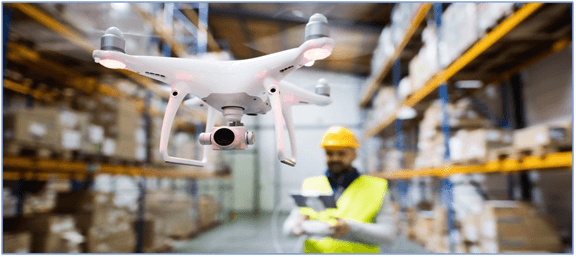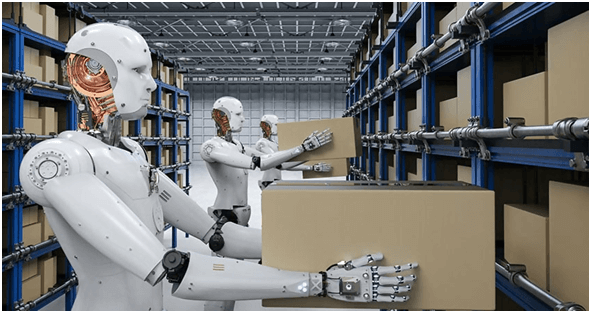Digital businesses use technology to create new value in business models, customer experiences and the internal capabilities that support its core operations. The term includes both digital-only brands and traditional players that are transforming their businesses with digital technologies.
Most digital businesses fit one or both of these points, they focus on creating value at new frontiers for their core business, or they use digital technology to drive growth, revenue and performance in ways that were impossible with traditional models.
It may be helpful for companies to review common elements of digital business and compare them against their own business models. These are some of the trends that differentiate digital from traditional processes.
Table of Contents
Drone Technology
Drone usage in the warehouse will vary based on the operation. However, here is the typical rundown of the work your flying robotic co-worker will perform
• The drone is tasked with counting the inventory amount of Item A, which is contained in boxes that are stored on the top shelves of an aisle.
• The Warehouse Management System (WMS) is fully integrated with the drone’s software. From this, the drone can access inventory location data down to the specific aisle, rack, or bin level.
• The drone maps out the optimal travel path to the stock location. The drone has an optical system that combines with computer vision and deep learning technology, which is a sub-field of machine learning that allows it to recognize images based on a network of learning layers.
• The drone arrives at the stock location, which it knows based on X, Y, Z coordinates.
• The drone visually inspects the labels, takes a photo of the bar-code, or uses RFID sensors to relay the inventory count to the central WMS.
Here we can see how efficiently the drone works. It saves the human worker from having to locate the stock, walk the distance to the aisle, climb up a platform, and manually scan all the boxes to perform a simple count. In fact, drone scanning can be performed 50 times faster than manual capturing.
The drone’s photos upload to the system instantly. But in the case of tagging error or discovery of inventory shortage, the drone generates a report that the operator can review and act on.

The benefits of drone technology are as follows:
• Speeds up the inventory counting process
• Performs inventory tasks with higher accuracy
• Lowers the costs of human labor
• Minimizes the risk of workplace injury
• Reduces downtime when operations have to halt for inventory checks
• Human labor can move to higher value jobs as drones take over the repetitive ones
• Integrates with all WMS and ERP system software
• Accepts all bar-code formats.
Robotics Technology
New robotics technology has become one of the most sought after technologies for warehouse management. Leading-edge manufacturers are partnering with providers of warehouse management systems to create customized software and smart robots that help manage the movement, storage, and sorting of warehouse inventory.
Investing in warehouse robotics technology will highly benefit you. With increasing order volumes, numerous products to navigate, highly personalized order packing and faster shipping requirements, robotics solutions will help you effectively respond to volume growth and perform more tasks with less labor and at a lower cost.

Benefits of Robotics technology are as follows;
• Reduction in labor costs
• Improved efficiency
• Minimal processing errors
• Expedited movement of goods within the warehouse and across the supply chain
• Tedious tasks automated by robots
• Human resources redirected to more complex tasks
• Workplace injuries reduced
• Competitive edge gained
Radio Frequency Identification (RFID)
RFID is an acronym for “radio-frequency identification” and refers to a technology whereby digital data encoded in RFID tags or smart labels are captured by a reader via radio waves. RFID is similar to barcoding in that data from a tag or label are captured by a device that stores the data in a database.
RFID has taken away much of that administration effort, by allowing operatives to simply scan a pick face and enter picked quantities on a keypad. More advanced solutions even eliminate the data entry altogether, leaving the operative to concentrate solely on the actual picking. Scanning technologies have had a similar impact in other areas of warehouse operation, such as receiving, put-away, and dispatch.
Here are the top 5 reasons why RFID should be used in warehouses:
• Tags do not have to be seen in order to read data. This means that tracking products or people can happen from anywhere in a specified range which maximizes speed and efficiency.
• RFID tags can store up to 100 times the data of barcodes, allowing you to keep track of all the data you need for your inventory such as lot and serial number, size, manufacturer, vendor, expiration date, user, location on a production line and anything else you might want to know.
• Readers can read up to 200 tags at once. This will increase speed and productivity since employees will not need to physically scan each label.
• The position of each tag is flexible (as long as they are not blocked by metal or water) since the tag doesn’t need to be physically seen by the reader. For example, you can place tags in boxes or within a pallet.
The full content is only visible to SIPMM members
Already a member? Please Login to continue reading.
References
Ann Chong Fong Ting, DPSM. (2018).“Warehouse Technologies for Effective Inventory Control”. Retrieved from SIPMM: https://publication.sipmm.edu.sg/warehouse-technologies-effective-inventory-control/, accessed 01/03/2019.
Cerasis. (2018). “7 Innovative Warehouse Management Technologies to Adopt”. Retrieved from https://cerasis.com/2016/12/21/warehouse-management/, accessed 01/03/2019.
Clearspider. (2019). “The Future of Warehouse Technology: Drones”. Retrieved from https://www.clearspider.com/blog-warehouse-technology-drones/, accessed 01/03/2019.
Clearspider. (2019). “The Future of Warehouse Technology: Robotics”. Retrieved from https://www.clearspider.com/blog-warehouse-technology-robotics/, accessed 01/03/2019.
Helmi Salleh, ADLSM. (2019). “Autonomous Devices for Digital Warehousing”. Retrieved from SIPMM: https://publication.sipmm.edu.sg/autonomous-devices-digital-warehousing/, accessed 01/03/2019.
Liferay. (2019).“What is Digital Business”.Retrieved from https://www.liferay.com/resources/l/digital-business, accessed 01/03/2019.
Systemid. (2015).“What is a Barcode Scanner and How Does it Work”. Retrieved from http://www.systemid.com/learn/barcode-scanners-and-how-they-work/, accessed 01/03/2019.

